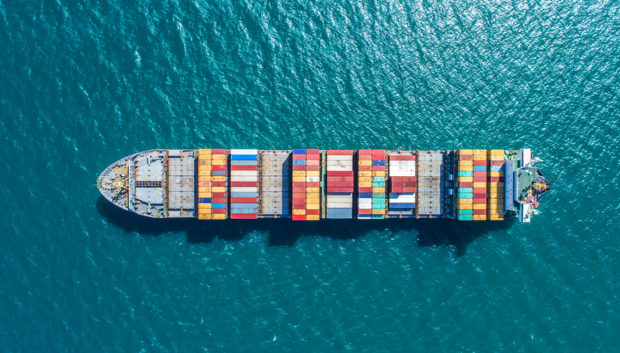Large shipping losses dropped by 20 percent last year, in a continuation of decade-long trend when losses declined by almost 70 percent, according to a report published by Allianz Global Corporate & Specialty (AGCS).
However, the report warned that the coronavirus crisis could endanger the long-term safety improvements in the shipping industry as difficult operating conditions and a sharp economic downturn present a unique set of challenges. (See below for the top 10 challenges facing the industry as a result of the pandemic).
AGCS attributed the improved loss picture to sustained efforts in the areas of regulation, training and technological advancement.
“However, what has been achieved can be easily lost if standards are not maintained. While total losses have reduced significantly, the total number of incidents has actually increased year-on-year,” said Ulrich Kadow Global Head of Marine Allianz Global Corporate & Specialty, in a statement from the report, titled Safety and Shipping Review 2020.
“It does not take much for a serious incident to result in a total loss and, hence, the warning signs are there,” said Baptiste Ossena, Global Product Leader Hull Insurance, AGCS.
Findings from the report include:
- 41 large ships were lost worldwide in 2019, down by more than 20 percent from 2018.
- The number of shipping incidents (2,815) was up 5 percent over 2018.
- Claims from machinery issues caused more than one in three incidents (1,044).
- Cargo ships (15) accounted for more than one-third of vessels lost in the past year, while foundered (sunk/submerged) ships were the main cause of all total losses, accounting for three in four (31).
- Bad weather accounted for one in five losses.
- Issues with car carriers and roll-on/roll-off (ro-ro) vessels remain among the biggest safety issues. Total losses involving ro-ros are up year-on-year, as well as smaller incidents (up by 20 percent).
- The South China, Indochina, Indonesia and Philippines maritime region remains the top loss hotspot, accounting for almost 30 percent of losses over the past year, with 12 vessels.
- Number of smaller shipping incidents rose in the waters of the British Isles, North Sea, English Channel and Bay of Biscay (605), which meant these waters replaced the East Mediterranean as the top hotspot for the first time since 2011, accounting for one in five incidents worldwide.
- There were almost 200 reported fires on vessels over the past year, up 13 percent, with five total losses in 2019 alone. Mis-declared cargo is the root cause of fires on board, said the report, explaining that chemicals and batteries are increasingly shipped in containers and pose a serious fire risk if they are mis-declared or wrongly stowed.
- With reports of a 400 percent increase in attempted cyber-attacks on the maritime sector since the coronavirus outbreak, shipowners are increasingly concerned about the prospect of cyber-conflicts. There has been a growing number of GPS spoofing attacks on ships, particularly in the Middle East and China.
Coronavirus Challenges
The report also included a section on the challenges of the coronavirus crisis, noting that the shipping industry has continued to operate through the pandemic, despite disruption at ports and to crew changes.
While any reduction in sailings due to coronavirus restrictions could see loss activity fall in the interim, the report highlights 10 challenges that could heighten risks, detailed below:
- The inability to change crews is impacting the welfare of sailors, which could lead to an increase in human error on board vessels.
- Disruption of essential maintenance and servicing heightens the risk of machinery damage, which is already one of the major causes of insurance claims.
- Economic fallout from the coronavirus pandemic threatens to unwind years of safety gains, triggering “an uptick in losses from cost-cutting measures, fatigued crew, idle vessels and weakened emergency response.”
- Cargo damage and delay are likely as supply chains come under strain.
- Disruption to maintenance raises machinery damage and breakdown concerns as the pandemic hinders essential maintenance and servicing.
- Delays with analysis of bunker fuel by shore-based laboratories increases the risk of engine damage. With the introduction of the cap on sulphur emissions under IMO 2020, many vessels have switched to using blended low-sulphur fuels, which require analysis prior to use in order to avoid engine damage and machinery breakdown.
- Disruption to surveys, port inspections and emergency response could endanger safety.
- The cruise ship industry faces an uncertain future with laid-up vessels, questions over how they can operate during the pandemic and potential liabilities. A number of cruise lines face coronavirus-related legal action from crew, passengers and investors.
- The growing number of cruise ships and oil tankers in lay-up around the world pose sizable risk accumulation, due to the potential threat from extreme weather, piracy or political risks. As of April 2020, some 95 percent of the global cruise fleet was in lay-up, with almost half in and around the Americas, said the report, quoting Lloyd’s List Intelligence.
- As the demand for oil dropped during the coronavirus crisis, millions of barrels of oil are being stored on tankers. Many tankers are idling around major oil ports and terminals in the US, Europe and Africa, with potential exposures to extreme weather, piracy and political risks.
“Shipowners also face additional cost pressures from a downturn in the economy and trade,” says Captain Rahul Khanna, Global head of Marine Risk Consulting at AGCS. “We know from past downturns that crew and maintenance budgets are among the first areas that can be cut and this can impact the safe operations of vessels and machinery, potentially causing damage or breakdown, which in turn can lead to groundings or collisions. It is crucial that safety and maintenance standards are not impacted by any downturn.”
Source: Allianz Global Corporate & Specialty (AGCS)
*This story ran previously in our sister publication Insurance Journal.





















 Travelers: Distracted Driving Incidents Continue to Rise
Travelers: Distracted Driving Incidents Continue to Rise  Pennsylvania Issues ‘Expectations’ for Carriers Regarding AI Use
Pennsylvania Issues ‘Expectations’ for Carriers Regarding AI Use  Ford Recall of 43,000 SUVs Due to Fire Risk Won’t Remedy Gas Leaks
Ford Recall of 43,000 SUVs Due to Fire Risk Won’t Remedy Gas Leaks  Triple-I: Insurance Economic Drivers Outperform Overall U.S. GDP
Triple-I: Insurance Economic Drivers Outperform Overall U.S. GDP 










